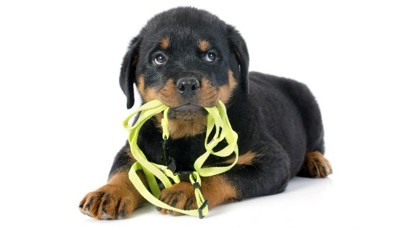How to Read a Dog's Body Language

A dog’s body language and behaviour can cue you into how it’s feeling – happy and relaxed, or nervous and fearful. Learn to read the signs and you’ll know whether your pet is happy to proceed.
We've put together some useful points and tips to help while you're out and about. Including socialising with other dogs.
Happy and Relaxed
|
Nervous and Fearful
|
Approaching Someone Else's Dog
So you’re running errands and you spot something irresistible – an adorable dog out with its human. Often, a person’s first instinct in this situation is to drop everything and rush up for a petting session. The dog and owner may put up with this, but it might make them uncomfortable or lead to an unexpected response.
So how does one approach in a way that’s polite and respectful to both the canine and its owner? Liz has a few tips…
1. Greet the human first
As much as you may be taken with a cute little puppy or a handsome canine, focus first on the human the dog is with.
2. Ask the owner for permission
Before approaching a dog you don’t know, ask the owner’s permission, as there may be good reasons why it’s not a good time for interaction. The dog may be ill and not itself, potentially making its behaviour erratic, the dog may be in training, or it may find meeting strangers stressful. If a pet is without its owner, it’s best to leave it well alone.
3. Avoid eye contact
Dogs have their own code – try not to make direct eye contact. Dogs may see this as a challenge or it might make them feel uncomfortable.
4. Avoid a head-on approach
If you can, position yourself so that you’re walking or standing beside the dog rather than coming at it directly from the front. If the dog and owner are approaching you, turning your body sideways conveys a decreased threat from the dog’s perspective. At the same time, however, it’s always good to keep your peripheral vision peeled to ascertain the dog’s body posture. If he seems stiff and is facing you, you may want to keep moving along.
5. Don’t bend over the dog
People are usually taller than dogs, so it may seem natural to bend over them, but this is rarely a good approach when greeting a dog that’s unfamiliar with you. Depending on the situation, you can squat down and get more on its level, at a distance that respects its space.
6. Let them come to you
Invite the dog into your space – this is a consent test in itself – and if the dog does not come to you, it doesn’t want to be touched. Use encouraging verbal sounds such as kiss noises.
7. Appropriate interaction
You might have to fight your natural instincts on this one, but try to not act overly familiar with the dog. While the dog may put up with cuddling or hugging, there’s a good chance that it is not comfortable with having a stranger so close. Instead, be calm, relaxed, and allow the dog a bit of breathing room.
8. When a dog is done interacting, respect that
When a dog allows you to step into its space, let it decide how long the “close encounter” should last. If it moves away, let it. The dog has allowed you to say hello, so let that suffice for your first introduction. Never reach toward a dog that has backed away from you.
Children and Dogs
When it comes to dogs and kids, it’s usually the humans who need to be taught how to behave, rather than the other way around. Though they’re furry and cute, dogs aren’t toys, and children need to understand this.
According to Liz Clough, a qualified Dog Trainer, children should always be supervised around dogs, and must be taught how to handle dogs nicely – “know that they don’t like hugs or kisses, that you must ask permission first before approaching, let the dog come to the child, pat from the collar to the tail, pause to see if the dog would like to retreat.”
Liz says there are some good organisations in New Zealand that teach children safety around dogs such as Kids Safe With Dogs. As for the dog, watch its body language to make sure it’s not feeling uncomfortable.


